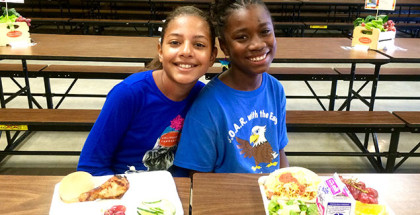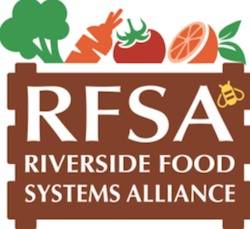farm to school
Hub-to-school: Food Hubs and Schools in Vermont Work Together to Drive Localization of Food System
February 1, 2016 | AJ Hughes
Volunteers pose next to boxes of gleaned food, all destined for a Vermont food hub. Numerous food hubs in the state supply produce to schools. (Photo courtesy Abbey Willard/Vermont Agency of Agriculture, Food and Markets)
Food hubs and farm-to-school programs are essential mechanisms in increasing access to food produced locally and sustainably. In Vermont, an effort is underway to combine the power of both.
As the recipient of a USDA farm-to-school grant in 2013, the Vermont Agency of Agriculture, Food and Markets (VAAFM) produced a report titled “Using Food Hubs to Create Sustainable FTS (Farm-to-School) Programs.” It explores how to leverage “non-traditional resources to expand farm-to-School market relationships between Vermont’s schools and producers.”
The publication was released in March 2015, and now, more than nine months later, VAAFM local foods administrator Abbey Willard is pleased with its impact. Read More
From 20 to over 220 Schools, California Thursdays Farm-to-school Program Growing Fast
December 29, 2015 | Anne Craig
Farmer Bob Knight of Old Grove Orange in Redlands, CA., lunching with some satisfied customers.
Photo courtesy of San Diego Unified School District
It started small, with 20 elementary schools eating fresh local lunch every Thursday. Now, San Diego Unified School District’s farm-to-school menus are being served up at over 220 schools in the district to 132,000 kids. The ultimate goal is to have all 26 million meals a year be fresh, local and made from scratch, and district officials believe it can be done.
“We were able to grow the program rapidly,” says Tara McNamara, marketing coordinator for the district’s Food and Nutrition Services department. “We started last October at 20 elementary schools, and that expanded to 60 by the end of last school year. Now we’ve got 225 at the beginning of this year.” Read More
To Get Kids to Consume Their Fruits and Veggies, Riverside, CA Farm-to-School Leader Goes Local
January 21, 2015 | AJ Hughes
A Riverside Unified School District student holds up an apple which he is about to eat. Through the efforts of Rodney Taylor and others, students in the Riverside Unified School District are actively encouraged to eat more fruits and vegetables. (photo courtesy of Rodney Taylor/Riverside Unified School District)
In the Riverside Unified School District (RUSD) in Southern California, students enjoy access to locally-sourced salad bars and experiential learning opportunities in agriculture and nutrition.
Much of this success has been spearheaded by Rodney Taylor, a noted farm-to-school expert and Director of Nutrition Services for Riverside Unified School District (RUSD).
In 1997, Taylor led a similar effort in the Malibu and Santa Monica school districts. But while those areas are known for their affluence, Riverside has more economic challenges. So when Taylor wanted to increase healthy food options for public school students in Riverside, there was no shortage of doubters.
Taylor did not see why healthy eating in public schools should be difficult anywhere. His goal is and always has been a simple one: “To get kids to consume their fruits and vegetables.” Through achieving this goal (and then some), he has proved his doubters wrong.
The numbers tell the story. In 2005, the RUSD farm-to-school program was just a pilot project, with one school salad bar. By 2010, all 31 schools in the district offered salad bars. And while the program is revenue neutral for the district, it generates income for the small, local farmers who supply the fruits and vegetables. Read More
Speakers at Seedstock’s “Grow Riverside” Conference to Examine Opportunities for Urban and Local Ag
December 3, 2013 | Robert PuroRiverside, CA – How can cities leverage unused agricultural land to increase the supply of locally available and create new jobs and farmers? What small scale urban agriculture solutions are bearing fruit? Is it possible to create an economically viable farming business on one or two acres of land? How can the USDA help? What are innovators in the sustainable urban agriculture space doing? What policy needs to be put into place to facilitate an active agricultural economy in a city and on its fringes?
These and other questions will be the focus of Seedstock’s upcoming Grow Riverside: Citrus and Beyond! conference, which is set to take place on March 19 – 20 at the Riverside Convention Center in Riverside, CA. The event will feature urban agriculture innovators, key policy makers, nutrition experts, and investors, who will partake in a two-day, outcomes-based conference to examine solutions to help cities, Riverside in this particular case, to galvanize their citizens, growers, advocates, government officials and other major stakeholders around the economic opportunities that can result from employing sustainable urban agriculture.
Some of the innovators and noteworthy presenters who will address these issues include:
 Pierre Sleiman is a young entrepreneur who has become involved in the mission of accelerating the movement towards local and sustainable farming and fostering interest in youth to choose agriculture as an exciting career. Pierre is the founder and CEO of Go Green Agriculture, a local farming business that grows local, high-quality leafy greens. He has been named as one of the “50 People to Watch in 2013” by San Diego Magazine and has been featured in over two-dozen other publications and live news broadcasts. He holds a Masters degree in Business from UC San Diego and a double Computer Science/Business bachelor’s degree from UC Riverside. Pierre was also recently elected to the Board of Directors of the San Diego Farm Bureau. Read More
Pierre Sleiman is a young entrepreneur who has become involved in the mission of accelerating the movement towards local and sustainable farming and fostering interest in youth to choose agriculture as an exciting career. Pierre is the founder and CEO of Go Green Agriculture, a local farming business that grows local, high-quality leafy greens. He has been named as one of the “50 People to Watch in 2013” by San Diego Magazine and has been featured in over two-dozen other publications and live news broadcasts. He holds a Masters degree in Business from UC San Diego and a double Computer Science/Business bachelor’s degree from UC Riverside. Pierre was also recently elected to the Board of Directors of the San Diego Farm Bureau. Read More











